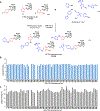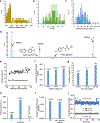Continuous collective analysis of chemical reactions
- PMID: 39663496
- PMCID: PMC11823688
- DOI: 10.1038/s41586-024-08211-4
Continuous collective analysis of chemical reactions
Abstract
The automated synthesis of small organic molecules from modular building blocks has the potential to transform our capacity to create medicines and materials1-3. Disruptive acceleration of this molecule-building strategy broadly unlocks its functional potential and requires the integration of many new assembly chemistries. Although recent advances in high-throughput chemistry4-6 can speed up the development of appropriate synthetic methods, for example, in selecting appropriate chemical reaction conditions from the vast range of potential options, equivalent high-throughput analytical methods are needed. Here we report a streamlined approach for the rapid, quantitative analysis of chemical reactions by mass spectrometry. The intrinsic fragmentation features of chemical building blocks generalize the analyses of chemical reactions, allowing sub-second readouts of reaction outcomes. Central to this advance was identifying that starting material fragmentation patterns function as universal barcodes for downstream product analysis by mass spectrometry. Combining these features with acoustic droplet ejection mass spectrometry7,8 we could eliminate slow chromatographic steps and continuously evaluate chemical reactions in multiplexed formats. This enabled the assignment of reaction conditions to molecules derived from ultrahigh-throughput chemical synthesis experiments. More generally, these results indicate that fragmentation features inherent to chemical synthesis can empower rapid data-rich experimentation.
© 2024. The Author(s), under exclusive licence to Springer Nature Limited.
Conflict of interest statement
Competing interests: D.J.B. is listed as an inventor on patents relating to TIDA boronates, and St Jude Children’s Research Hospital have filed patents relating to the new fragmentation patterns described in this study.
Figures














References
-
- Abolhasani M & Kumacheva E The rise of self-driving labs in chemical and materials sciences. Nat. Synth. 2, 483–492 (2023).
-
- Santanilla AB et al. Nanomole-scale high-throughput chemistry for the synthesis of complex molecules. Science 347, 49–53 (2014). - PubMed
Grants and funding
LinkOut - more resources
Full Text Sources

